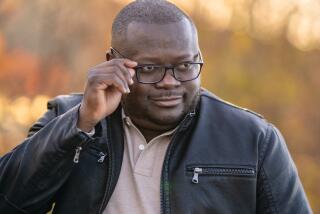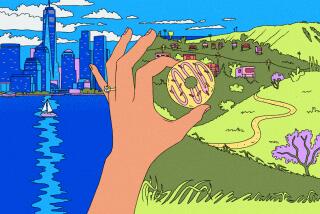An American tale Ken Burns was driven to tell
- Share via
Imagine a time when America had just 150 miles of paved roads and 8,000 automobiles; when laws required drivers to give a week’s notice before taking a trip; when you would be smart to bet against a man who said he could drive a horseless buggy from San Francisco to New York in less than three months.
The year was 1903. The man was Horatio Nelson Jackson, one of those all-American types who never gives up. The story of how Jackson, mechanic Sewell K. Crocker and a bulldog named Bud completed the first transcontinental crossing by automobile in 63.5 days jumps up and cries out to be made into a documentary by Ken Burns, the filmmaker who gave us “The Civil War” and “Baseball.”
“Horatio’s Drive: America’s First Road Trip,” Burns’ film about Jackson, written by Dayton Duncan, is to be broadcast Oct. 6 on PBS stations. The documentary explores serious social changes that ensued when America put the horse to pasture, but “Horatio’s Drive” is a little different from Burns’ previous work because it is, above all, nutty, amazing and fun, set to the romping strains of a silent picture-era piano.
On one red-letter day, Jackson and company had to use a block and tackle 18 times to pull the car out of the mud. Their cherry red Winton touring car had neither roof nor windshield, which is why the passengers, including Bud, wore goggles.
There were frustrating delays in hinterland towns caused by the need for spare parts, delivered by railroad and stagecoach. And to put a ridiculous coda on the trip, shortly after Jackson got home to Burlington, Vt., he was arrested for driving over the 6 mph speed limit.
I don’t know which part of me “Horatio’s Drive” appealed to more: the history buff or the traveler. Regardless, it was with unthrottled appreciation that I recently chatted with Burns by phone. We talked about the film and America’s passion for the road.
Question: My favorite thing about the film is the loopy detail. [For instance, Jackson’s wife, Bertha, was born to a family that manufactured Paine’s Celery Compound, composed of 20% alcohol.] Why does American history seem so singularly colorful?
Answer: I don’t know. I have been doing this for 30 years and have never been able to get infected by any other country’s story. We have a particularly potent mix that has to do with the collision of cultures and our ability to move up in the world.
Q: How did you come upon this material?
A: My longtime partner Dayton Duncan had been regaling me with this story for 13 years. He got it from reading a book on the Lincoln Highway with a three-paragraph mention of Jackson. Then he and his wife did some detective work -- computer searches, visits to funeral homes -- and found Jackson’s granddaughters. One of them had the letters and telegrams he sent to his wife during the trip. That was all it took.
Q: They are wonderful. He calls her “Swipes” and signs off, “Yours until New York, Nelson. P.S. I am fine, the only trouble is I miss you so.” What about him appealed to you?
A: He was an American Everyman. We got Tom Hanks to do his voice.
Q: How did you make the film?
A: We used the hundred or so stills Jackson took, and Dayton went to historical societies in every little town where he stopped, to look for material. Then we followed the Winton’s tracks in a Chevy Suburban. We shot black-and-white digital video and then “distressed” it with a computer program. Most of the route is now on numbered highways and interstates, so we had to go off road to find the right settings. We put a camera and cinematographer Allen Moore in an absurd harness -- we called it “the bra” -- on the hood of the car.
Q: Did you have any adventures?
A: We were waiting for the light in southwest Wyoming -- [Bureau of Land Management] land, I think -- on a dirt track surrounded by sagebrush, with nothing to tell whether it was 1903 or 2003, near the route of the Pony Express, California, Mormon and Oregon trails. Then the light changed. We put Allen in the harness and deliberately drove into a ravine, just as two cowboys rode by. One of them said, “I’m going to get free drinks in the bar for a month when I tell them about this.” Like Horatio, we got lost in southwestern Wyoming. Eventually, we found ourselves at Cruel Jack’s Truck Stop, where those of us who had the burrito grande wished we hadn’t.
Q: To what do you attribute America’s fascination with the road trip?
A: In Europe, they go fast and get there, or take the train. In America, we’re too big and bullheaded for public transportation. And we have these cars that allow us to go wherever and whenever we want, which conspire with our magnificent landscape.
I am always excited by a new stretch of road. But road trips are not to be taken lightly. Think of the movie “Thelma and Louise.” They have complicated undertows.
They have to do with self-definition.
I remember carrying my father’s ashes from Michigan to New Hampshire in 2001 and a 1969 road trip from Ann Arbor [Mich.] to march against the war in Vietnam in Washington, D.C., when I had waist-length hippie hair. I have introduced my two daughters to America in the car. They were always great travelers. When my oldest was 2 1/2, we tossed her bottle off the Cape May [N.J.]-Lewes [Del.] ferry; it was a huge moment.
Q: What are you working on now?
A: A series on our national parks, in five parts, scheduled for 2009. Every year, I go to two or three of them. I have the best job in the world.
More to Read
Only good movies
Get the Indie Focus newsletter, Mark Olsen's weekly guide to the world of cinema.
You may occasionally receive promotional content from the Los Angeles Times.










